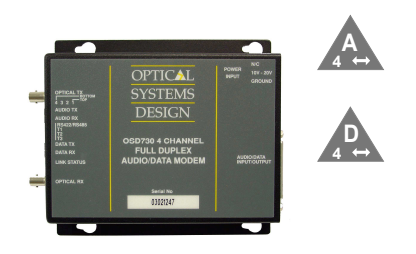Audio video data

OSD730 FULL DUPLEX FOUR CHANNEL DIGITAL AUDIO/DATA SYSTEM
PRODUCT DESCRIPTION
- Supports 4 full duplex audio and data channels
- Data can be RS232 or RS422 on all four channels with one channel also RS485 capable
- User settable turnaround delay on RS485 channel
- Broadcast quality 18 bit digital audio transmission
- Available as a card or as a sturdy standalone module

OSD158T/OSD158R ALARM TRANSMISSION SYSTEM
FEATURES AND BENEFITS
- Supports 4 full duplex audio and data channels
- Data can be RS232 or RS422 on all four channels with one channel also RS485 capable
- User settable turnaround delay on RS485 channel
- Broadcast quality 18 bit digital audio transmission
- Available as a card or as a sturdy standalone module
APPLICATIONS
- Studio audio distribution
- Duplex sound stage to console connection
- Campus audio program distribution
- Public address systems
- High end intercom systems
TYPICAL APPLICATION DESIGN

specifications
ELECTRICAL
Audio Channels
- Number of Channels [ 4 ]
- Nominal Level [ 0dBu (775mV) nominal ]
- Headroom [ 18dB ]
- Input Impedance [ 600Ω or 10kΩ (user selectable) ]
- Output Impedance [ 200Ω ]
- Format [ Balanced input and output ]
- Signal to Noise Ratio [ >70dB at nominal level ]
- Total Harmonic Distortion [ <0.05% at nominal level ]
- Bandwidth (-3dB) [ 10Hz to 20kHz ]
- Indicators [ Red indicator for active transmit channels ] [ Green indicator for active receive channels ]
DATA
- Number of Channels [ 4, each operating at up to 100kbps ]
- Data Interface [ RS232 or RS422 on all 4, RS485 available on channel 1 ]
- Channel 1 Controls [ RS485/Normal ]
- Turnaround delays adjustable from 43μS to 87mS (8 steps)
- Indicators [ Red indicator for active transmit channels ] [ Green indicator for active receive channels ]
OPTICAL
- Optical Wavelength [ 850nm (OSD730) ] [ 1310nm (OSD730L) ]
- Transmit Power [ -15 to -10dBm into multimode fiber (OSD730 only) ] [ -15 to -10dBm into singlemode fiber (OSD730L only) ]
- Receiver Sensitivity [ <-39dBm ]
- Receiver Saturation [ >-12dBm ]
- Link Budget and Transmission Distance [ >24dB (>7km for multimode, >60km for singlemode) ]
- Link Status Indicator [ Green for established optical link, red for no optical link. ]
- Optical connectors [ ST Standard ]
ENVIRONMENTAL, PHYSICAL, POWER
- Operating Temperature [ -20 to +75°C ]
- Relative Humidity [ 0 to 95% non-condensing ]
- Dimension of Module (mm) [ 104W x 144D x 25H ]
- Weight of Module [ 400g ]
- Dimensions of Card (mm) [ 25W x 208D x 100H ]
- Weight of Card [ 200g ]
- Power Requirements [ 10 to 28VDC or 15 to 20VAC @ 4VA ]
- Chassis Current Consumption (CCC) [ 0.30 Amp ]
44 PIN FEMALE D CONNECTOR PIN ASSIGNMENTS

Request a Quote
Learn More From
Frequently Asked Questions
Multimode fiber commonly comes in 50/125 μm or 62.5/125 μm core/cladding dimensions, with bandwidth capacities ranging from 200 MHz to 2 GHz, depending on the grade. Multimode systems typically support transmission distances of up to 5 km, making them suitable for short- to medium-range applications.
In contrast, singlemode fiber—usually 9–10/125 μm—offers significantly lower attenuation and effectively unlimited bandwidth, supporting links over 150 to 200 km, especially when paired with optical amplifiers and advanced transceivers.
While singlemode fiber is less expensive per meter, its associated transceivers and equipment tend to cost more than their multimode counterparts. That said, singlemode devices are generally compatible with both singlemode and multimode fiber, whereas multimode equipment works only with multimode fiber.
Let me know if you’d like this turned into a quick-reference table or visual comparison—it’d make a solid inclusion for a fiber deployment guide.
The link budget is the difference between the transmitter’s output power and the receiver’s sensitivity. This budget must account for all signal losses along the path, including:
- Fiber attenuation due to the transmission medium
- Connector losses, such as those at patch panels or equipment interfaces
- Splice losses from mechanical or fusion joints
- Link margin, which provides a buffer for unforeseen variations
The link margin typically ranges from 2–3 dB in tightly controlled environments to up to 10 dB in more variable conditions. It is designed to accommodate:
- Component aging (e.g., light sources may degrade and lose up to 3 dB over time)
- Temperature variations affecting transmitter output or receiver sensitivity (up to 3 dB may be needed for thermal fluctuations)
- Physical cable damage and repair-induced losses (usually minor, but more relevant in harsh or industrial settings)
Always design your system for worst-case scenarios to ensure reliability. However, don’t overlook the best-case condition either—some optical receivers may exhibit erratic behavior if the incoming signal is too strong.
First, verify the optical signal strength along the link. Use an optical power meter to measure the received power at the fiber’s end point. Typical transmit levels range from –8 dBm to –15 dBm, while the receiver sensitivity is around –31 dBm, giving you a link budget of approximately 16 dB. This margin supports transmission distances of up to 10 km on singlemode fiber and about 3–5 km on multimode fiber.
If the measured power falls below the receiver sensitivity, there’s a strong likelihood of issues with the installed fiber. Ideally, initial OTDR readings should have flagged such faults.
If not, inspect the patch cords currently in use for possible defects or misalignment. A frequent oversight is the use of mismatched patch cords.
Multimode fiber types are classified by the ISO/IEC 11801 standard into five main categories: OM1, OM2, OM3, OM4, and OM5. Each type differs in core size, bandwidth, supported data rates, and maximum transmission distances. Here’s a quick breakdown:

- OM3 and OM4 are laser-optimized and widely used in modern data centers.
- OM5 supports shortwave wavelength division multiplexing (SWDM), enabling multiple wavelengths over a single fiber for higher capacity.
- All OM types are backward compatible in terms of connectors, but mixing core sizes (e.g., OM1 with OM3) can cause performance issues.
